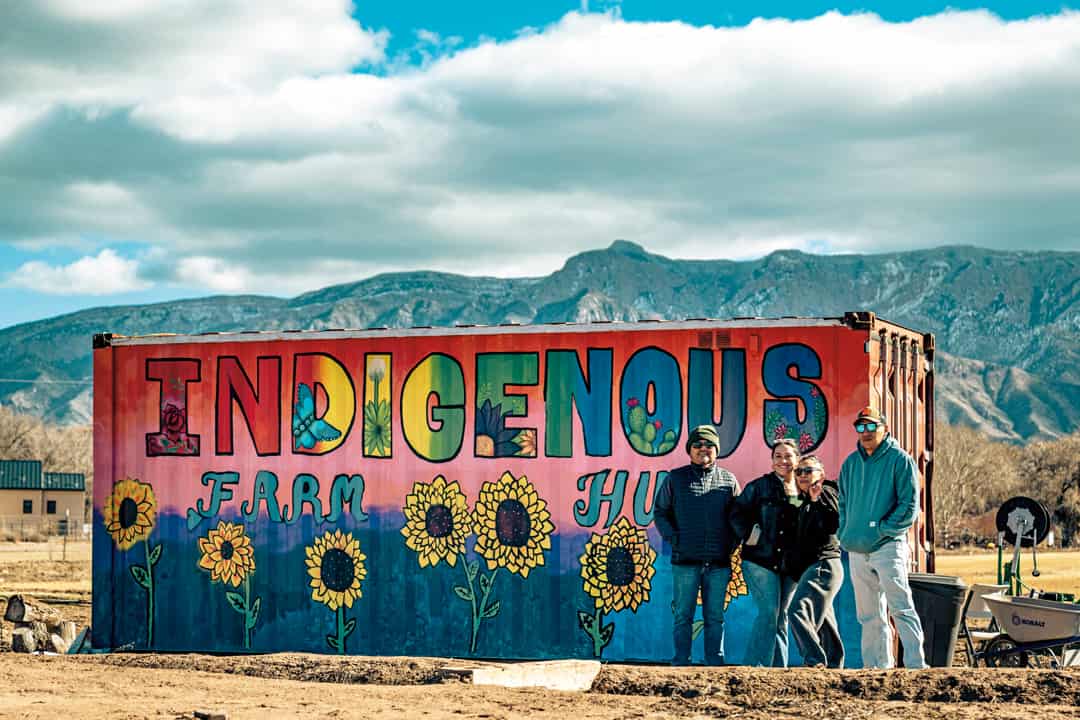By Shahid Mustafa

On a regular basis, I ask myself, What is going to happen with water? As a farmer in southern New Mexico, this is one of my most challenging questions. I ask knowing that some 80 percent of the state’s water is allocated to agriculture and that, according to the New Mexico Environment Department, 95 percent of the state’s limited rain and snowmelt evaporates or is transpired by vegetation. Whether through agricultural use, natural vegetation, or landscaping, the limited resource necessary for everyone’s survival quenches a lot of thirst; what’s left is available for residential, industrial, or commercial consumption. How we collectively steward our water will determine the future habitability of our communities. The fact is we live in a desert, but unlike the historic nomadic peoples who once populated this landscape, we have developed a series of fixed living spaces that don’t allow for the transient lifestyle that long-term survival in this environment seems to support. As influx and demand increases, we are also experiencing extended drought conditions that significantly reduce the availability of water. The majority of the water we depend on in the state is drawn from aquifers that are replenished by cumulative rainfall and the surface water running through the Rio Grande (some of which is diverted from the San Juan tributary of the Colorado River). According to the National Integrated Drought Information System, between the years 2020 and 2023, 88 percent of the state experienced drought, with nearly 78 percent of conditions categorized as severe, extreme, or exceptional.
The USDA Census of Agriculture reports that dairy is the top agricultural product in New Mexico, followed by cattle. Together, these two industries account for 85 percent of the state’s total revenue from agriculture. These industries and the animals they raise are very thirsty. Dairy cows consume between 15 and 35 gallons of water per day, more during periods of heat stress. The environmentalist nonprofit Food & Water Watch estimates that the volume required to provide drinking water and produce feed for industrial dairy cows in the state is over 11 billion gallons annually. It’s unclear if that estimate includes any of the surface water and groundwater required to irrigate alfalfa, a predominant New Mexican crop that is produced primarily for livestock feed and that also depends on large amounts of water. Most dairy producers grow alfalfa and hay both for export and as a supplemental crop for their animal feed. Because many farmers still practice flood irrigation, many of the gallons of water used to irrigate alfalfa are exposed to the arid conditions and lost in the evaporative cycle. Farmers who pump groundwater for irrigation use metered wells, and the usage rate costs are subject to change from year to year. In recent years, the cost of watering livestock and producing feed has increased substantially, and these costs have been instrumental in the closure of many of the state’s dairy farms. From its peak in July 2004 through January 2023, New Mexico lost 43 percent of its dairies.


De Smet’s cows are never confined, free to graze, and fed a variety of grasses, including alfalfa, buckwheat, triticale, and radishes. Photos courtesy of De Smet Dairy Farms.

Mike De Smet, a third-generation dairy farmer in Bosque Farms, is not exempt from those challenges, but his operation is an exception to the mega-dairy trend. De Smet Dairy Farms operates on 150 acres with about 60 head of cattle and produces about 150 gallons of whole raw milk daily. De Smet transitioned the farm from “conventional” farming to regenerative farming, and has used no-till practices for about eighteen years. De Smet’s cows are never confined, free to graze, and fed a variety of grasses including but not limited to alfalfa, buckwheat, triticale, and radishes. As a result of his farming methods, which include rotational grazing, De Smet says his farm never has any bare land, has an abundance of earthworms and other microbial activity, and can retain enough moisture to grow for four weeks midsummer without any irrigation. He likes to use alfalfa because of its high nutrient content and its resilience as a crop, but he doesn’t believe monoculture will allow him to achieve the same results he has reached by seasonally planting multiple varieties. From his experience, De Smet believes that the maximum size of his herd will never exceed 60 head of cattle. “I can only milk what the land will allow me to produce,” DeSmet says when asked how much he anticipates his herd can produce in the future. “I’m not willing to sacrifice quality for quantity. We’re a counter to what the big dairies are doing; it’s a different model.” He admits that a lack of water in-season has really affected their practices, as he depends on surface water from the Rio Grande. “My land has surface water rights, and our rights are attached to the land. Other farmers are water banking.” Water banking refers to the act of routing surface water to groundwater storage basins; selling water rights; or, as in this case, leasing water rights to other farmers or commercial operations for usage. De Smet adds, “In my opinion, people that hold the rights to the water should stay on the land.”

Middle Rio Grande Valley. Photo by Stephanie Cameron.
In New Mexico, a water right is held as real property, and can be leased or sold with some restrictions. The right to access water in New Mexico for consumptive, agricultural, commercial, or industrial use is administered by the New Mexico Office of the State Engineer (OSE) through the Water Rights Allocation Program. The application process can be costly, so smaller producers often purchase or lease water from existing owners of water rights. Companies such as WaterBank, which acts as a brokerage and investment bank for water, post national listings of water rights available for lease or purchase. With many New Mexico dairy farmers struggling to make it or shutting down operations due to decreased demand and overproduction, one viable option for recovering losses or paying off debt is selling their water rights. In fact, some former dairy operations in Doña Ana County are now listing their properties as water rights acquisitions.
As troublesome as the current agricultural management of water may seem, the most likely investors in water in New Mexico are not other farmers but developers and speculators, such as Vidler Water Resources based in Nevada. Vidler’s stated mission is “to help facilitate and support planned economic growth through the development of sustainable and reliable water supplies in geographic areas lacking available water resources.” According to its website, Vidler’s four-phase process for water resource development includes identification and acquisition, permitting, development, and sale. In 2009, Vidler joined with the Campbell Farming Corporation to file an application with the OSE for 717 acre-feet of groundwater to provide water for an 8,000-acre residential and commercial development in the East Mountains called Campbell Ranch. If approved, Vidler would own 95 percent of the developed and permitted water rights for the project, slated to include 4,000 homes and a golf course. Because of the potential impact on the Sandia Underground Water Basin and the community’s water supply, neighboring residents protested the application, launching a fourteen-year battle to protect existing domestic wells from the new appropriation.
“My well is already going down due to development,” says Zach Withers, who, along with his brother Ethan, owns Polk’s Folly Farm in Sandia Park. Polk’s Folly operates on 40 acres, with 7 acre-feet of water rights, sourced from the same Sandia Basin aquifer from which Campbell Ranch wanted to appropriate 500 million gallons per year. Zach and Ethan’s farm breeds around 150 hogs a year along with a few laying hens. He estimates that they use about 150 gallons per day for farming operations. When asked for his opinion on water allocation for agriculture, residents, and business, he offered, “I think that access to affordable potable water should be a right and we should have enough water to feed ourselves. What I see happening is the opposite of that. How quickly can we turn our water resources into money? Right now, we get twelve to eighteen inches of precipitation [annually]. That’s enough water to support maybe one acre-foot for every two acres.” Speaking to projects such as Campbell Ranch, sited on historic grazing land, he said, “They’re building homes with no consideration for what happens when the aquifers run dry, and through private utilities replacing agricultural water use with residential. My community is twenty to forty years out from running out of groundwater.” Withers’s comments reflect a growing concern in the East Mountains over how water allocations do or do not benefit the greater community.

Inset: Zach Withers (right) playing in the pond on his property (Polk’s Folly Farm) when he was young. Above: A dead cottonwood on the bank of the long dried out pond. The cottonwood and the willows died off this year after several years without running water in the stream. Photos courtesy of Zach Withers.
The depth of that concern is evident in the role that local opposition has played in stalling the Campbell Ranch development. In December 2022, the New Mexico Court of Appeals affirmed a 2019 district court decision that in turn affirmed the OSE’s determination that the new appropriation was not in line with water conservation and would impair existing wells.
How water is regulated moving forward will determine the sustainability of our communities in relation to feeding ourselves, meeting our everyday needs, and preserving one of our most vital resources. The complications surrounding the stewardship, management, and control of water can seem overwhelming. But what we are experiencing on a global level due to climate change is a crisis that demands a collaborative, urgent response. There appear to be competing interests for what should be understood as an essential and vital resource necessary for the literal existence of all humans. The quandary lies in the fact that in the case of water, the competing interests of agriculture, housing, and economic development are intertwined in such a way that none can be summarily dismissed.
Being a farmer, I exist at the intersection of at least two of those interests. My own concern with water is one reason I practice regenerative agriculture, which emphasizes water conservation. My experience so far has been promising. In three growing seasons I’ve seen my soil transform, resulting in healthier plants and greater moisture retention even through this past summer of extended extreme heat. A level of accounting for conserving water when it comes to new housing developments likely already exists within zoning committees, and it’s time for all of us to demand they and other bodies within residential development be transparent and accountable when it comes to water conservation. As it stands, water on paper is not currently supported by the water in the ground, which means it is a currency very similar to the dollars that circulate through our economy. With that in mind, it seems that we all should have personal and collective accountability when it comes to our most finite and vital resource. A system that incentivizes responsible water stewardship and allows us to “bank” water responsibly would seem appropriate.

Polk’s Folly pigs. Photo by Stephanie Cameron.

Shahid Mustafa
Shahid Mustafa owns and runs Taylor Hood Farms, practicing regenerative organic agriculture on more than three acres in El Paso, Texas, and offering a CSA with home delivery. Through his nonprofit organization DYGUP/Sustain (DYGUP stands for Developing Youth from the Ground Up), he has worked with the science department at Las Cruces High School to implement an environmental literacy curriculum and establish a one-acre plot where students receive credit for helping with all stages of vegetable production. With plans to become a certified organic farm and train a new generation of farmers, he hopes his efforts will be an inspiration for farmers to adopt the regenerative organic practice.

















